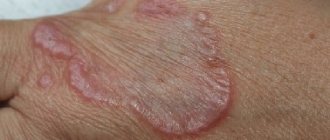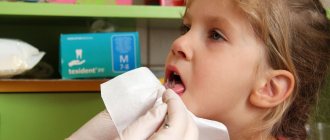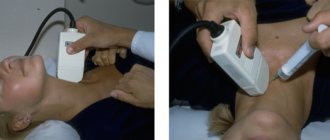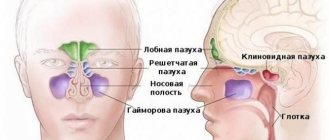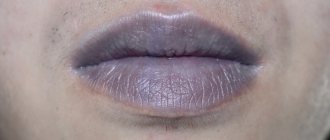Published: 10/22/2021 15:15:00 Updated: 10/25/2021
Sore throat is a disease of an infectious nature, manifested by acute inflammation of the lymphoid tissue of the pharynx. Most often the process affects the palatine tonsils, but other structures of the lymphadenoid pharyngeal ring can also be affected - the lingual and pharyngeal tonsils, lateral ridges or granules of the posterior pharyngeal wall.
The pathology in question is characterized by symptoms of intoxication, increased general temperature, sore throat that worsens during swallowing, enlarged and painful cervical lymph nodes. The palatine tonsils and arches are swollen, enlarged, bright red, and may have a white or dirty yellow coating.
Treatment of sore throat includes local treatment with antiseptics, painkillers and anti-inflammatory drugs, antibiotic therapy and detoxification measures. If complications develop or the process becomes chronic, surgical intervention may be required.
Causes of sore throat
Most often, inflammation is caused by the activity of beta-hemolytic streptococcus group A. Among the possible causative agents of the disease are also adenovirus, staphylococci, pneumococci, parainfluenza virus, mycoplasma, chlamydia, rhinovirus, respiratory syncytial virus, spirochete, Epstein-Barr virus, diphtheria bacillus, enterovirus Coxsackie B, fungi.
The risk of developing a sore throat increases when exposed to the following factors:
- general or local hypothermia;
- weakened immunity due to acute respiratory infections;
- fungal diseases;
- chronic pathologies of the nasopharynx, difficulty in nasal breathing, purulent processes and inflammation in the paranasal sinuses;
- caries;
- systematic exposure to irritating substances on the body, work in a smoky or dusty room;
- increased air dryness;
- regular drinking of alcohol, smoking;
- acute and chronic intoxication;
- poor nutrition, lack of vitamins in the diet.
How is a sore throat usually treated: antibiotics or antivirals?
There is a misconception that this disease is exclusively of bacterial origin and therefore can only be treated with antibiotics (but in 60% of all cases, the sources are actually bacteria - hemolytic streptococcus, staphylococcus, pneumococcus).
However, there are microorganisms of other origins that also provoke tonsillitis (chlamydia, mycoplasma), and about 40% of cases of tonsillitis are associated with viral or fungal pathogens that are activated in the body as a result of hypothermia, wet feet, and decreased immunity. Often viruses are a prerequisite for the development of bacterial and other forms of tonsillitis. If a viral sore throat is not promptly and competently treated, it can quickly turn into a bacterial one, when, indeed, “heavy artillery” is required in the form of mandatory antibiotics (macrolides, cephalosporins, etc.). At the first signs of this disease, you should immediately make an appointment with a doctor.
Types and symptoms of sore throat
Depending on the cause, angina may be primary if the site of inflammation is initially localized in the tonsils.
A secondary or symptomatic type of pathology is considered a manifestation of another disease - infectious mononucleosis, diphtheria, scarlet fever, tularemia, typhoid fever, leukemia, alimentary-toxic aleukia, agranulocytosis. Inflammatory damage to the palatine tonsils is called tonsillitis, and to the nasopharyngeal tonsils - adenoiditis. There is also tonsillitis of the lingual tonsil, lateral ridges of the pharynx and laryngeal tonsillitis.
Based on the depth and nature of inflammation of the lymphoid tissue, the following forms of the disease are distinguished:
- catarrhal;
- lacunar;
- follicular;
- ulcerative-membranous;
- necrotic;
- combined.
Characteristic manifestations of any form of angina are general symptoms of intoxication, including increased body temperature, weakness, decreased appetite, headache, as well as enlarged and painful regional lymph nodes.
The incubation period depends on the type of pathogen and the state of immunity, ranging from several hours to a week or more. Other signs of angina, such as sore throat and external changes in the tonsils, may have varying severity depending on the form of the disease.
Catarrhal
The inflammatory process primarily involves the mucous membrane of the tonsils.
The disease begins acutely. The temperature during catarrhal tonsillitis rises within 37.1-38.0 °C, symptoms of intoxication and sore throat during swallowing are moderate. Characterized by enlargement of the lymph nodes located in front of the sternocleidomastoid muscle at the level of the angle of the lower jaw. The palatine tonsils are moderately swollen, their mucosa, as well as the surface of the palatine arches and the soft palate, are brightly hyperemic. The duration of the disease is 2-3 days, after which recovery occurs or a transition to a more severe form occurs.
Viral sore throat occurs with symptoms of ARVI - runny nose, cough. When infected with Coxsackie enterovirus, blistering rashes are observed on the mucous membrane of the palate and tonsils.
Lacunar and follicular
The clinical course of both lacunar and purulent tonsillitis is severe.
Characterized by fever from 38.0 to 40.0 °C, severe intoxication syndrome: headache, general weakness, aches in joints and muscles, pain in the projection of the heart, chills, sleep and appetite disturbances. The pain in the throat during swallowing is sharp, often radiating to the ear. Severe inflammatory changes lead to dysphonia - the voice takes on a nasal tone. Swelling of the tonsils may be accompanied by difficulty breathing and temporary hearing loss. When a child has a sore throat, there may be increased salivation, drowsiness, vomiting, convulsions, and abnormal bowel movements. In the first 2-4 days, the symptoms increase rapidly, and then disappear just as quickly. In the lacunar form of the disease, in addition to swelling and pronounced redness of the mucous membrane, white, irregularly shaped overlays with a yellowish tint appear on the tonsils, which can be easily removed with tweezers. In the case of follicular tonsillitis, suppuration of the follicles occurs; individual pinpoint yellowish formations of regular shape, no larger than a pinhead, appear through the epithelium. The tongue is dry, covered with a white coating. On the 4-5th day, the surface of the lacuna begins to clear, and the purulent blisters gradually disappear.
Necrotic
The most severe form of the disease. A pronounced intoxication syndrome is characterized by persistent fever, impaired consciousness, and repeated vomiting that does not bring relief. Dirty yellow spots with a greenish tint, ulcers and ulcers appear on the surface of the tonsils.
Ulcerative-membranous
Simanovsky-Plaut-Vincent angina is caused by a spirochete and a spindle-shaped rod that constantly live in the oral cavity.
With exhaustion, a pronounced decrease in immunity or hypovitaminosis, opportunistic microorganisms can become active, causing inflammation. The difference between ulcerative membranous tonsillitis and other forms is the one-sidedness of the process. An ulcer with a gray-yellow coating on the surface appears on the tonsil mucosa. Characterized by a putrid odor from the mouth, moderate sore throat and enlarged regional lymph nodes on the same side as the inflammation. Symptoms of intoxication may be absent or mild. The duration of the disease is from 7 to 12 days. After cleansing of plaque, the ulcerative defect heals without scar formation. Extensive ulcerations can lead to bleeding, damage to the periosteum, and perforation of the palate.
How to treat herpes (herpetic) sore throat
It is in this case that antibiotics will definitely not have the desired effect. The cause of herpes sore throat is the herpes virus. And treatment of the herpetic form of the disease involves taking drugs based on acyclovir. But this group of antiviral drugs has contraindications due to age and pregnancy. Therefore, antiviral drugs that do not have such restrictions (for example, VIFERON) come to the rescue.
Scheme of use of the drug VIFERON (suppositories) for herpetic sore throat
| Nosology and | Adults Dosage | Children Dosage | Pregnant Dosage |
| Herpetic infection | 10 days VIFERON® 1,000,000ME 1 suppository 2 times a day | 5 days VIFERON® 150,000 ME 1 suppository 2 times a day | 10 days VIFERON® 500,000 ME 1 suppository 2 times a day: then maintenance courses are prescribed in accordance with the instructions for medical use |
Scheme of use of the drug VIFERON (gel) for herpetic sore throat
| Nosology | Patients | Dosage regimen | Course duration |
| Herpetic infection | Children, adults, pregnant women | Apply a strip of gel no more than 0.5 cm long to the affected surface 3-5 times a day | 5–6 days. |
Author of the article
Belyaev Dmitry Alexandrovich
General doctor
Loading...
Take other surveys
Complications of sore throat
During the disease, the infection can spread to neighboring organs, causing otitis media, lymphadenitis, sinusitis, and peritonsillitis. Among the local purulent complications of tonsillitis, one can note the formation of an abscess or phlegmon in the inflamed tissues. Their occurrence is accompanied by a new wave of fever, increasing sore throat, problems with swallowing and breathing. In the case where the pathology is caused by streptococcus, 3-4 weeks after clinical recovery, glomerulonephritis, reactive arthritis or rheumatic carditis may develop due to subsequent autoimmune processes.
How to choose a medicine
Advice from friends will not help when choosing a remedy for the treatment of sore throat; you must be guided by what will be suitable for the patient in the opinion of doctors. Consultation with a specialist and diagnostics will allow us to identify the cause of the disease and the correct strategy for action in a particular case. You should not use folk remedies as the main method of treatment, because... incorrect tactics can lead to serious complications. Criteria for choosing a drug to combat tonsillitis:
- appropriate medication indications;
- there should be no contraindications to the medication in the patient’s medical history;
- minimal list of side effects;
- compliance with the patient's age;
- the drug is not addictive;
- only the best manufacturers - the brand must have existed for a long time, have no experience in consumer lawsuits, use high-quality components and undergo the necessary certification;
- drug suitable for the price.
Diagnosis of sore throat
At the patient’s initial visit, the doctor collects complaints and anamnesis, specifying the duration and circumstances of the onset of symptoms, and the nature of the pain.
This is followed by a general examination of the patient, a visual assessment of the mucous membranes of the mouth and throat, and palpation of regional lymph nodes. An endoscopic examination of the ENT organs – pharyngoscopy – is mandatory. It allows you to examine the tonsils in detail and thus determine the form of the disease. For angina, the following tests are prescribed:
- Clinical blood test. Inflammation is indicated by neutrophilic leukocytosis with a shift to the left and accelerated ESR.
- General urine analysis. It is possible that protein may appear in the biomaterial.
- Rapid test from the tonsils using diagnostic strips to detect group A beta-hemolytic streptococcus.
- Bacteriological examination of a smear for beta-hemolytic streptococcus and diphtheria. Material is collected from the surface of the palatine tonsils and the posterior wall of the oropharynx before using local antiseptic drugs and taking antibiotics.
- If a patient is suspected of having infectious mononucleosis, a blood test is performed to test for IgM antibodies or to identify the genetic material of the Epstein-Barr virus.
- As part of the diagnosis of herpetic sore throat, enterovirus RNA is determined in the blood and throat smear using the PCR method.
Diagnosis of complications of angina after clinical recovery includes the following laboratory and instrumental studies:
- Control general analysis of blood and urine.
- Rheumatic test. Determination of rheumatoid factor, C-reactive protein, antistreptolysin-O, seromucoid in the blood.
- ECG. The electrocardiogram may show signs of hypoxia and conduction disturbances.
What brand of sore throat remedy is better to choose?
There are a lot of companies supplying the Russian market and pharmacy chains with antibiotics, antihistamines, anti-inflammatory and immunomodulatory drugs. Their list is constantly expanding, as are new generations of drugs. Before looking for a reliable product for yourself, get acquainted with the reputation of its manufacturer.
The following companies were approved by experts:
- Obninsk Chemical and Pharmaceutical Company was founded in 1999 on the basis of a scientific institute. After the construction of workshops for the production of finished dosage forms, the range expanded significantly. The company was included in the list of the best high-tech fast-growing companies in the Russian Federation.
- Schering-Plough is an international company that has focused all its activities on an in-depth study of the market conditions for therapeutic programs. Founded in 1971, in recent years the brand has been recognized as a leader in biotechnology.
- Egis is a Hungarian pharmaceutical plant that annually replenishes pharmacy chains around the world with antihistamine, antibacterial, and cardiovascular drugs. Successful activities have been going on for about 10 years, and regularly 9% of profits go to scientific development.
- Pliva is a Croatian pharmaceutical company, a leading supplier of pharmacies in Central and Eastern Europe. The main part of the products are successful generics of the world’s “blockbusters” in the field of medicines, which became famous thanks to effective forms of Adderall.
- Lek is a Slovenian company founded in the 40s of the last century. After some time, she joined the Swiss company Novartis, which provided access to the world market. In terms of volume of products sold today, Lek ranks 1st in the United States.
- GlaxoSmithKline is an English company formed in 2000. Today it is the largest supplier of quality patented medicines in the world. In the pharmaceutical business, it is a leading player with an important mission - improving the quality of life of humanity.
- Pharmstandard is the largest and most influential Russian manufacturer of medicines. More than 1.7 billion packages are produced annually; these are safe, high-quality products that meet the standards of pharmaceutical practice.
- Aziende Chimiche Riunite Angelini Francesco Roma is an Italian pharmaceutical company that has been operating for 100 years. Today, this brand works closely with the international company Red Cross, providing high-quality effective medicines to different segments of the world's population.
- Anzhero-Sudzhensky HFZ is a Russian company that produces analgesics, anticonvulsants, bronchodilators and other drugs, including vitamins. The winning advantage lies in affordable prices and a strategy for promoting innovative drugs.
- Bayer is a famous German brand founded in 1863. The original drugs that made this name famous were Aspirin and Heroin. The company has expertise in the field of natural sciences, which is unofficially considered an indicator of high quality.
- Reddy's is an Indian pharmaceutical company founded in 1984. Today, it is not only a supplier of inexpensive, effective generics, but also has its own patented products and provides services.
- Reckitt Benckiser is a British company that is today a world leader in the development and sale of medicines, hygiene, health, and household products. The main task is to introduce innovations to improve the quality of life. The RB portfolio offers 19 brands.
- Laboratoires Bouchara – Recordati is a French company founded in 2000 through the merger of two companies, Recordati from Italy and Bouchara from France. The goal is to produce finished medicines of the gastroenterological, cardiological, antimicrobial, urological groups, as well as analgesics.
- Bosnalek is an international company with offices in many countries. It produces drugs from the fields of cardiology, neurology, gastroenterology, dermatology, otolaryngology, and pediatrics. Successful activities have been carried out since 1951.
Treatment of sore throat
Depending on the severity of the patient’s condition, treatment of angina occurs under the supervision of a doctor at home or in a hospital.
Bed rest is mandatory, a gentle dairy-vegetable diet enriched with vitamins, and plenty of warm drinks are recommended. For bacterial sore throat, broad-spectrum antibiotics are prescribed. If the disease is caused by streptococcus, penicillin drugs are used. In case of severe intoxication syndrome, intravenous infusion of glucose-saline solutions is performed. Non-steroidal anti-inflammatory drugs are used as antipyretics and pain relievers.
For sore throat, gargling with alkaline and water-salt solutions and irrigating the pharynx with painkillers and antiseptics are recommended. The use of drugs in the form of a spray for the treatment of sore throat is possible only in adults and children over 3 years of age. With the development of purulent complications of the disease, hospitalization of the patient followed by surgical intervention is required.
Author:
Pugonina Tatyana Alekseevna, Therapist
Rating of remedies for sore throat
To treat such a complex disease as sore throat, doctors usually prescribe a whole range of drugs. Much depends on the etiology, symptoms, type of pathogen, course and possible complications. Experts studied and tested certified antibiotics, anti-inflammatory and antiallergic agents, antiseptics, and immunomodulators. The rating includes the best remedies for sore throats that are recommended by medical specialists, as well as the patients themselves, who assessed their effectiveness from their own experience.
The following criteria were also taken into account when selecting nominees:
- The cause of sore throat is bacteria, viruses;
- The severity of the course is the stage of the inflammatory process;
- Symptoms – signs, complications;
- Special instructions, conditions - contraindications, side effects;
- Release form: tablets, solutions, sprays, lozenges;
- Toxicity level – the lower the better.
The main rule of choice for such a disease is a doctor’s prescription. Many people look at the country of origin and price, so those options were selected that best cope with their tasks, with minimal impact on the digestive organs and general health.
The best drugs for the liver


